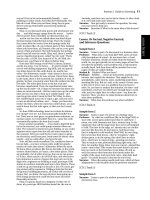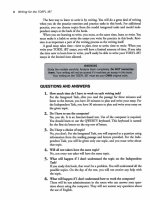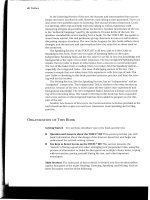The grammar translation the direct m the audio lingual m 2
Bạn đang xem bản rút gọn của tài liệu. Xem và tải ngay bản đầy đủ của tài liệu tại đây (59.06 KB, 5 trang )
METHODOLOGY 1
STOP AND CHECK 1
Name: ……………………………………………………….
Which of the following statements describes characteristics of the Direct Method (D)? And
which describes the Grammar Translation Method (GT). Circle your choice.
1. Classes are taught in the mother tongue, with little active use of the target language.
D GT
2. New teaching points were taught through modeling and practice.
D GT
3. Much vocabulary is taught in the form of listed of isolated words.
D GT
4. Long elaborate explanations of grammatical rules are given.
D GT
5. Classroom instruction was conducted in the target language.
D GT
6. Grammar was taught inductively.
D GT
7. Grammar provides the rules for putting words together, and instruction often focuses
on the form and inflection of words.
D GT
8. Only everyday vocabulary and sentences were taught.
D GT
9. Reading of difficult classical texts is begun early.
D GT
10. Correct pronunciation and grammar were emphasized.
D GT
11. Often the only drills are exercises in translating disconnected sentences from the
target language into the mother tongue.
D GT
12. Oral communication skills were built up in a careful traded progression organized
around question-and-answer exchanges between teachers and students in small,
intensive classes.
D GT
13. Both speech and listening comprehension were taught.
D GT
14. Little or no attention is given to pronunciation.
D GT
15. Concrete vocabulary was taught through demonstration, objects, and pictures, abstract D GT
vocabulary was taught by association of ideas.
Match each description of class activities (1-10) with its technique from the GrammarTranslation and the Direct Method (A-J). Write your answer in the boxes.
A.
Getting students to self-
F.
G.
H.
correct
B.
C.
D.
E.
Reading aloud
Fill-in-the-blank exercise
Question and answer exercise
Map drawing
Dictation
Conversation practice
Deductive grammar
treatment
I.
J.
1
Paragraph writing
Memorization
1.
The teacher asks students to take turn to read part of a passage, play, or dialog out
loud. Teacher uses gestures, pictures, relia, examples, etc. to explain meaning of
each part.
2.
The teacher gives several examples for a new word/ concept after explaining a
grammar point.
3.
The teacher repeats a student’s sentence using questioning voice or/and giving
another alternative.
4.
The teacher asks the whole class questions related to the passage, the class
answers in full sentences.
5.
The teacher reads a text aloud 3 times, students write down what they hear.
6.
Stundents fill in the blanks with appropriate words from the lessons to complete
some sentences.
7.
Two students ask each other questions, using the same grammatical structure in the
target language.
8.
Students write a paragraph in their own words, using the reading passage in the
lesson as a model.
9.
The teacher says a word and asks students to say its antonym/ synonym
10. The students listen to the teacher and label a map.
Which of the following statements describe the Audio-lingual Method? Which does not?
Circle your choice.
1. Dialogs are useful way to introduce new material.
2. Students’ native language should be kept apart so that it interferes as little as
possible with their acquisition of the target language.
3. Students need to memorize grammar rules in order to use the language.
4. It is important to prevent learners from making errors.
5. Positive reinforcement helps students to develop correct habit in the target
language.
6. Vocabulary is important and should be taught before structural patterns.
7. Students can initiate their own interactions in some stages of the lessons.
8. Speech is more basic to language than the written form.
2
9.
The learning of a foreign language should be the same as the acquisition of the
native language.
10. Teachers direct and controll all the language behaviors of the students.
Match each description (1 – 7) to Audio-Lingual techniques (A – G). Write your answer in
the boxes.
A. Backward build-up (expansion) drill
B. Repetition drill
C. Chain drill
D. Single slot substitution drill
E. Multiple-slot substitution drill
F. Transformation drill
G. Question-and-answer drill
3
1.
Teacher: Where are you going, John?
Students: Where are you going, John?
Teacher: I’m going to the post office.
Students: I’m going to the post office.
2.
Teacher: Where are you going? (points to a picture of a post office)
Students: I’m going to the post office.
Teacher: Where is he going? (points to a picture of a cinema)
Students: He’s going to the cinema.
3.
Teacher: post office
Students: post office
Teacher: to the post office
Students: to the post office
Teacher: going to the post office
Students: going to the post office
Teacher: I’m going to the post office.
Students: I’m going to the post office.
4.
Teacher: Where are you going, John?
Students: Where are you going, John?
Teacher: I’m going to the post office.
Students: I’m going to the post office.
5.
Teacher: the post office.
Students: I’m going to the post office.
Teacher: the cinema
Students: I’m going to the cinema.
Teacher: Mary
Students: Mary is going to the cinema.
6.
Teacher: I’m going to the post office. (points to a picture of a post office)
Students: I’m going to the post office.
Teacher: the cinema
Students: I’m going to the cinema.
Teacher: the bookstore
Students: I’m going to the bookstore.
Teacher: I’m going to the post office.
Students: Are you going to the post office?
Teacher: Peter is going to the beach.
Students: Is Peter going to the beach?
7.
These are some key terms related to the description of the Audio-lingual Method. Complete
the sentences below using one of the key terms given.
4
overlearn
habit formation
imitator
explicit grammar
contextualize
minimal pair
structural pattern
cue
1. To be able to communicate, students need to ……………………… the
target language, to learn to use it automatically without stopping to
think.
2. Teachers can use spoken or picture ……………………… to stimulate
students practice the target language.
3. Students are …………………. of the teacher’s model or the tapes s/he
supplies of model speakers.
4. Grammatical points are taught from the examples and drills, so
…………………. rules are not provided.
5. Because language acquisition results from …………………, students
need lots of drills to overcome the old habits of their native language.
6. Cultural information and vocabulary are …………………….. in the
dialogs.
7. After the teacher does the contrastive analysis, she asks students
discriminate similar sounds using ……………………..
8. The syllabus typically consists of ………………… included in the
new dialog.
5









